How to learn more about your Gruen watch.... a tutorial
One path to gaining more knowledge of your Gruen Wristwatch
So you have a Gruen watch that you've fallen for. Now what? Get to know your new pal that you're excited about! How about learning its
- Model name
- Age
- Maybe even a little history
You can do it, regardless of your current level of expertise. With Gruen wristwatches it is not as difficult of a task as it has been in the past. A few short years ago it was quite difficult because very few resources existed to help. Now a good number of books have been published meant specifically to help with this task and new serial number tables are being added every few months.
The tutorial presented here, is a presentation on how to use the Gruen identification and research tools that were written specifically help help collectors gain knowledge. If you own one of more of these books, then this tutorial will be of help in educating you on how to best use them. This page is not a sales pitch. The Gruen Identification books are meant to do what is described here, identify Gruen watches. If you don't care to purchase this body of knowledge, that's fine. Because they exist to help perform identifications, they will of course be the core of the techniques discussed below. A large amount of knowledge on Gruen watches has been compacted down into several books, all of which play some role in learning more about Gruen watches, their history, and the detailed data about each watch.In the title, I say "one path" because there is no definitive, hard-fast set of rules to utilizing facts at hand to identify, date, or gain general knowledge of your Gruen watch. This just happens to be one of the set of steps I follow to identify Gruens. I often deviate, make up new steps, recall past research that may help for this specific watch, or simply have momentarily forgotten part of the well-worn path I use.
The path refers to the journey, or trip I take, because finding the information is much like a journey through a maze of data. Sometimes it's an enjoyable trip. Other times, well, maybe not so much. Regardless of what direction you go please do this one thing.... don't give up easily. There a great number of opportunities for you to stop, but don't. Take the next step, learn as much as possible while you're neck deep in researching your particular watch, you may never go back and continue your education later.
The vast majority of Gruens have a model name. By model name I mean the name you see in Gruen ads, newspapers, what you would ask the jeweler to see back when your watch was originally made, and folks you meet at watch shows. You may already know, Gruens have names that somewhat categorize them such as Curvex, Veri-Thin, Quadron, Cartouche, and Baguette.
Before Gruen began using more marketable names such as the Croydon or Wesleyan, they used names such as "Strap 110". Some watches that are early in Gruen's history only have a Strap number, but the later models, after the late 1920's, generally have a model name that's more consumer friendlier and sexier.
A footnote for the category "Import". This term appears in The Gruen Watch Catalog, but has never been seen in an advertisement nor other Gruen publication. I believe it is unique to The Catalog and simply provided a unique label for these watches. The Imports use cases not made in the USA, thus the term "Import".
If you're already confused, don't worry, you'll either catch on, or get used to the state of confusion that comes along with being a Gruen collector.
My approach --- throw every tool I have at my disposal at the problem
No great secret there. Gather as much material that contain answers and then sift through it. The way I identify Gruens is to go through a progression, a series of steps, using a variety of tools. One way of thinking of this is as a mosaic. I've made an illustration of my mosaic of Gruen resources. You will see this illustration when you scroll down past the text. The information is divided into books, charts/tables, and advertisements. They are each discussed in this tutorial. The mosaic illustration is an easy way to check to see what you have and don't have at your disposal at the moment, an inventory so to speak.
Each step of my identification process adds confidence to estimates found in the previous steps, or perhaps adds completely new information, or invalidates the information you may have found up to that point. Keep going until you have run out of resources or have sufficiently satisfied yourself with the information you have examined.I'm source material agnostic as long as the data is solid. I use information whether it's in one of the books I've written or papers I've co-authored or not. I am by no means trying to do a hard sell of my books, but rather demonstrate to the folks that already own them how I use them. If you have been thinking of buying one, you can use this opportunity to see one way how they're used and make a more informed buying decision.
If you don't have any of the books, you're not stuck. There is a lot of information on this site provided for free that will greatly aid you in learning about your watch. USE THIS FREE INFORMATION! If you are an NAWCC member, then the entire library of books discussed here are at your disposal from the NAWCC library! ALL of the Identification books written by Mike Barnett can be checked out of the NAWCC library, so use your membership to borrow copies if you do not want to own a set.
The complete library of books currently in print that I will be pulling information from for this tutorial are all available from Lulu.com. These books are specifically written to help with identifying Gruen watches. Other books on Gruens are also available that are not specifically aimed at identification (such as the Repairer's Reference). They can help, but the primary purpose of that book is not identification. The Repairer's Reference, for example, has a table of all of the Gruen movements and their date of introduction at the beginning which can certainly be of help.
The Print Resources - These represent the body of knowledge of Gruen watches that has been gathered, organized, compacted, and made available for you to use to become better educated on Gruen watches.
Gruen Identification oriented books:
- The Gruen Watch Catalog - The most recent publication for Gruen collectors. Photographs of nearly all of the Gruen watch models from the 1920s to the 1950s
- The Gruen Stock Record Book 1927 - A counter catalog originally published by Gruen in 1927. Companion to the Gruen Watchmaker's Guild Book
- The Gruen Watchmaker's Guild Book 1929, 1930, 1932 - Counter catalog published by Gruen with supplements. Was a follow-on to the Stock Record Book of 1927
- The Gruen Watch Model Identification Guide Volume 1 - Full color identification guide
- The Gruen Watch Model Identification Guide Volume 2 - Expansion of Volume 1. Exact same format. Adds to the number of watches identified in Volume 1.
- The Gruen Watch Model Identification - Collector's Hard Cover Edition - Volumes 1 & 2 Combined
- Gruen The 1910s & 1920s Two Decades of Watches from the Daily News - Newspaper advertisements of Gruen watches.
- Gruen The 1930s A Decade of Watches from the Daily News
- Gruen The 1940s A Decade of Watches from the Daily News
- Gruen The 1950s A Decade of Watches from the Daily News
Additional Gruen books that may be helpful, but not specifically for Identification
- The Gruen Watch Repairer's Reference - Soft cover. Compilation of all known Gruen parts catalogs and supplements.
- The Gruen Watch Repairer's Reference - Hard cover
- The Gruen Horological Text and Technical Bulletins
STEP 0) Dates and The Date of Introduction
Let's talk DATES....
- Gruen The 1910s & 1920s Two Decades of Watches from the Daily News - Newspaper advertisements of Gruen watches.
- The Gruen Watch Repairer's Reference - Soft cover. Compilation of all known Gruen parts catalogs and supplements.
- The Gruen Watch Repairer's Reference - Hard cover
- The Gruen Horological Text and Technical Bulletins
There are FIVE dates that any particular Gruen watch can have attached to it.
1 -- Watch Birthday (Assembled Date)2 -- Style Number Date
3 -- Case Manufacture Date
4 -- Movement Manufacture Date5 -- Purchase Date
The more of these you have, the clearer the picture of your watch's history. These dates can vary, perhaps significantly (5+ years), from each other so it's important to know what they are and how they work.
#1 - Watch assembled date - this is the date your watch's movement had a dial and hands put on it, the movement was then put into a case when it was then timed and tweaked until.... A GRUEN WATCH IS BORN! Unlike the "Teddy Bear Factory", Gruen did not create Birth Certificates for their watches. There were a few exceptions, but generally speaking, it wasn't written down.#5 - Purchase date - If you have the receipt, you've got this date. If not, then tracking down an invoice with your watch shown on it would do the trick, but that's mega-unlikely (approximately)#3 - Case Manufacture Date is when Gruen or one of the MANY case manufacturers they used stamped out your case. The serial number in your case, thankfully, can be used in some cases, to get this date. It's obtainable!#4 - Movement Manufacture Date is when the movement was manufactured. Only 2 families of Gruens have been decoded (405 and 440), but more will show up soon!
And that leaves us with #2, the Style Number date....
3 -- Case Manufacture Date
4 -- Movement Manufacture Date
If you are going to find your watch in one of the Identification books, it is the date the watch was first made available for SALE that you are seeking. This is because it is this date that you will most likely find the watch in the books. When a watch was first introduced for sale is when it has the highest likelihood of showing up in print, in advertisements and catalogs. So keep this in mind as you search.... it is not the date your watch was manufactured that is needed in order to locate the model name and other details about your watch, it is the date it went on sale. A quick example. Suppose a watch was first made available to the public in 1940. If that watch was very popular, it was perhaps made for 4 years. If your watch was manufactured in 1944 and you manage to locate this date, it is unlikely that that you will find that watch still being advertised in 1944 even though it was still being manufactured. If you find the date of manufacture only you may not find the model name if you continue to work with that date only.
STEP 1) The Foundation Date - Your first step is to create what I call a "Foundation Date". This is your first guess, estimate, that you will refine, verify or invalidate as you proceed through the steps.
- The Caliber-Date table created by Barry Cooper that can be found in the Gruen Repairer's Reference. This table will tell you the date an estimated date that each movement caliber went into production. Using the caliber of the movement in your watch, you can find the date this movement went into production. This will at least tell you the earliest your watch's date is. Your Foundation Date will be the one found in the table and will likely move forward in time as you refine it.
- An earlier, simpler, and less accurate version of a Caliber-Date table. This table was created by the early Gruen pioneer Charlie Cleves and was published in Roy Ehrhardt's Master Book (no longer in print). It was originally published in the AWCI Horological Times journal in May 1989 (I told you he was early!). The NAWCC Library also has a letter Mr. Cleves he sent to Robert Gruen informing him of his findings.
- The Wadsworth Case dating technique - two of these have been developed, one by Jack Wood, the other by Barry Cooper.
- The case serial number tables for Gruen, Keystone, and Star manufactured cases - pinpoint when your specific watch was manufactured.
- The Serial Number of the watch movement - currently TWO movement families are supported. First the 405 family decode by Jack Wood and most recently, the 440 Curvex movements.
- The Gruen Watch Catalog - This book was published in 2015 and has photographs of nearly every Gruen watch model produced between the early 1920s and late 1950s. If you match your watch with a photo in the book, then you will be able get this additional information.... movement caliber(s) that your watch used. The different case materials your watch may have used. AND, where in time your watch was made relative to other watches. It takes a bit of experience to exploit the relative location to other watches, but with some time you'll learn what "era" your watch is in. See below for more about eras.
- Gruen Watch Model Identification Guide Volumes 1 and Vol 2 - These were the first of the color identification Guides published for Gruen watches and remain the books that will provide you the most data. Watches typically have a life-sized illustration, date (typically the date of Introduction for sale), the number of jewels of the movement, the various case materials used. If you have these, begin with them in your search.
- The Gruen "Decade Series" - Four identification books using newspapers as the source and include these books: The 1930s a Decade of Watches from the Daily News, The 1940s, The 1950s and The 1910s & 1920s... I've come to rely more and more, particularly for obscure watches.
- Gruen Wristwatches A Collector's Guide, by Bruce Shawkey. No longer in print. The Gruen Watch Catalog contains a super-set of the watches in the Collector's Guide.
- The Gruen Master Book, by Roy Ehrhardt & Sherry Ehrhardt, et al. The Gruen Watch Catalog is the color version of this book. It is further identified by Roy as a "Reprint of the Pocket & Wrist Watch Sections of the Master Gruen Factory Records Book". Shawkey used this Factory Records Book as the basis for authoring the Collector's Guide. Roy's Master Book is long out of print, but occasionally second generation copies are sold on eBay. The NAWCC Library has an authentic (not photocopied) copy you can access.
- The "Watch Price Guides". I'm not a big fan of "price guides". I've found a number of errors and completely wrong information for quite a few watches. They usually provide little Identification Data such as dates and model names. My opinion is that they are inaccurate, sometimes misleading, and have little value in the Identification process. However, if you have them, USE THEM. Use anything you can get your hands on, but temper the information you find with skepticism. That's my opinion and I'm not challenging your's. Roy Ehrhardt wrote 5 Price Guides and I believe all or most have pictures and information about Gruens. We know Roy sometimes made up names for watches, so caution is advised and a backup source is recommended for his and all price guides.
- Advertisements that I may have not used in my Model ID Guides. The Model Identification Guides and Decade Series books are all based on advertising. What they give you over individual ads is that the books organize, compact, and index the information found on individual ads. 100s of ads were used to create the books. If you can locate the raw materials for the books, then use them. It will take you more time of course as the ads have been sorted and information extracted for the books. The books also contain information from rare ads you may not be able to locate. But, again, if you have them or have access, use them.
- Reference material - You'll find the reference section of GruenWristwatches has quite a number of documents, tables, general information that may be of help to you. The many watch forums on the internet are filled with information on Gruens that have been archived from the past decade or more. And, of course, new information on Gruen watches is located and published on a weekly or monthly basis so keep checking the list of your favorite watch sites. The 1918 "Worthy Company" book is a counter catalog of early Gruen watches with pictures and descriptions of the watches for sale. The 1917 "Blue Book" pocket calendar also has a mini-catalog of Gruen watches identified.
If you are an NAWCC member, you're in luck because copies of almost all of these books have been donated to the library. Members can check out these books from the NAWCC library. If you are an AWCI member, they too have many of these books in their library available for checkout.
If you do not have a membership to either of these organizations, please consider joining. When looking at the dues, compute how much they cost monthly and you'll more easily see the dues are not that expensive in the whole scheme of things. Both organizations have monthly journals they send to you that are well-written. Bruce Shawkey, one of the authors of the books below is a Gruen expert and column writer for the NAWCC. He's written several Gruen specific articles as well as the previously mentioned book Gruen Wristwatches - A Collectors's Guide.
- The Gruen Watch Model Identification Guide - Volumes 1 and 2 - These are organized by date. I use the Foundation Date to start searching at that date and then outwards for 1 or 2 years. The pattern match time is small because of this. Additionally, each year's watches are grouped in either a men's or women's group. within the year. It's typically a fairly quick search since the watches are in color and are the same size as your physical watch. If a match is found, you will find a block of data to use in Step 7
- The Gruen Watch Catalog - Based on the same manuscript used to create The Gruen Master Book. This is the 2015, full color, duplication, of the source manuscript. This means you can own a copy of the priceless relic. The quality level is as if you had the original in your possession. Finding your watch in this Catalog is a straightforward task as the images are very clear photographs of each watch. The information it will provide is the "era" as the book is in a linear order. Additionally, the early Strap and Tank watches can be cross-referenced with the Guild Book and Stock Record Book detailed below. This book will give you a label (or Catalog Part Number as they are called in the book). The watches depicted are named using a numbering system such as "Strap xx", "Import xx", "Quadron xx", etc. For example, a 1945 Veri-Thin Epoch is identified as a "Strap 497". For the VT Epoch is says "caliber 430, Yellow or Pink Gold Filled". The Model ID Guide entry has a little more information. Its entry is 1945 Veri-Thin Epoch, 17 jewel Precision, pink or yellow gold filled case with expansion bracelet, original price $67.50.
- The Gruen Decade Series Books - Again I start from the foundation date and work outwards, perhaps by +/- 1 year, or if I'm feeling up for it, additional years. These books produce different data than the others. They are unique in that they often provide similar watch data as in Volume 1, but they also have the added benefit of often providing the full range of dates, the start and end dates, the watch was being sold. For the VT Epoch discussed above, the decade book uncovered an interesting "anomaly". The watch had 3 names in the course of 3 years. I haven't seen Gruen use two of the names, only the newspaper and each is only with 1 advertiser. There was clearly a little advertising trickery going on. The Epoch cost $67.50. One store called it the VT Embassy ($55.00), and another the VT Elliot ($67.50).
- The 1929 Gruen Watch Makers Guild Book - Published by Gruen, this book has 100's of watches with detailed information about each watch. The book usually has the Supplement "A" to the Gruen Guild Book. Many, if not the majority, of these watches were "pre-sexy" named watches. One exception is the Quadrons. Several Quadrons are named with names such as the Carlton, Arlington, Fleetwood, Longacre, etc. Others have model names but they are primitive sounding, examples include Design O1077, Design 3P105, Design 3W105 Ribbon. Not sexy names but at least named. However, many of these watches are named with a sequential number xxx preceded by Strap, Car., Bag., and Quad. These were numbered because Gruen was just beginning the practice of naming their watches with more marketable names. For these watches found in these specific documents, it's acceptable to use the sequentially numbered name. Names of watches in the Guild Book match the names in The Catalog. So if you find the watch in The Catalog, you can easily go to the entry in the Guild book to learn more about it.
Look at the top and bottom of the crystal. Is it a straight line where your picture is curved slightly? No? Goto step 3. When I say check every line, I mean every line. Every bump. The pictures and illustrations have proven to be very accurate when compared to physical watches. Another example, how many "steps" does the side of the case have? A step is where the side of the case cuts in and forms what looks like a stair step.
Another area to check is between the lugs, on the bezel itself. Some cases have a "window" that is raised from the bezel and holds the crystal. It's like a mirror laying on top of a box with a hole cut in it. If you're looking at one of these, check out that picture frame, all the way around. The area between the bezel is a great place to check widths of case features on those 2 sides of the case. That is, the short sides. Carefully eyeball the distance from the edge of the case to the edge of the crystal. Are ALL of the feature between those 2 edges identical? If the distance between them doesn't look identical, you haven't found your watch. Sorry. There are a lot of cases where this is the part that causes a watch to be ruled out. Once you see a few close matches you'll understand what you are looking for in a match.
You WILL spend the majority of your time in this step, performing it over and over for each potential match as you go through your reference materials. After all, an identification is really a pattern match between a picture and your physical watch. Practice in the doctor's office doing the kids' puzzle "What is missing from this picture compared to this picture?" Where's Waldo?
A word about dials. Some models of Gruen watches have distinctive dials that never vary. The Veri-Thin Eagle / Medallion is one example. The Veri-Thin Submarine another. The Gruen wristwatches in the 1950's have more of these models that have unvarying dials. However, this exact distinctive match is not the norm. Most watches can be fitted with a large number of dials. Yours may be a single color and the ones in the books have two-tone dials. It's OK. Just make sure that BEZEL MATCHES. The point is that if your dial is different than an example you have found in the reference material, give that fact little or no weight, unless you have specific knowledge that the dial is always the same for that model.
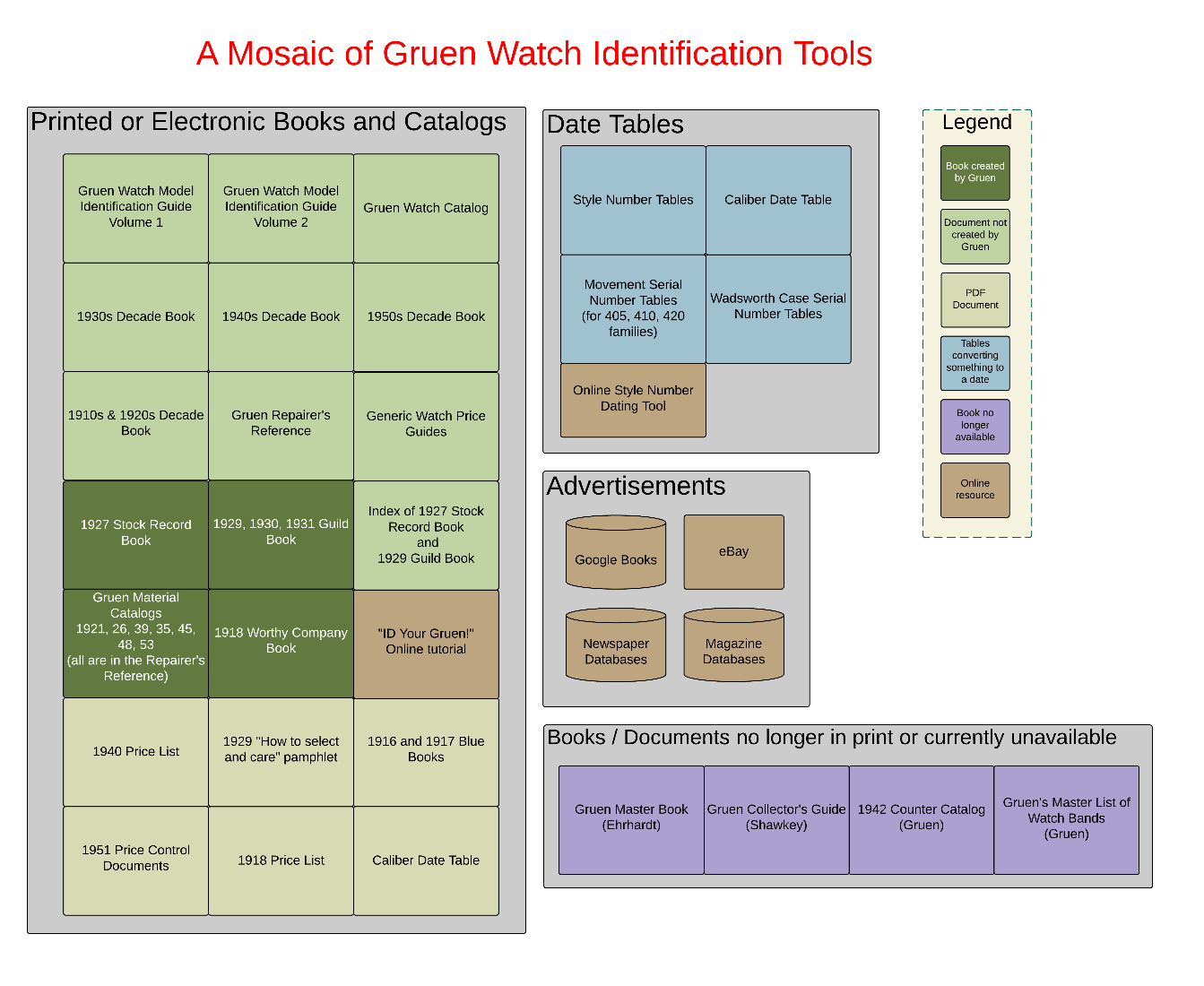
Example Scenarios - Use Cases
A 1952 Gruen Star Supreme
Uses Style Number + The Gruen Watch Identification Guide
Let's take a typical and straightforward example. Let's assume you have everything discussed at your disposal. Access to the web, the Identification books, etc.
Recall my first step is to always read the Style Number from the back of the case. This requires opening the case. You will find a tutorial on opening Gruen cases on this site. HOWEVER if you feel even the slightest amount of uncertainty, DO NOT TRY IT! Get some help. Any watchmaker can open the case for you and copy down the information stamped in the back.
I've opened this
Step #1 for me is to locate the Style Number and use it to obtain my Foundation Date using the Style Number Dating Technique.
In this watch, I see a Style Number of 752
This number 752 resulted in a date of 1952 using the Style Number Dating Technique. So, 1952 is my Foundation Date.
Stop #1, the Gruen Watch Model Identification Guides. Why there? They contain the most information about Gruen watches of any of the other books and are organized very well by date.
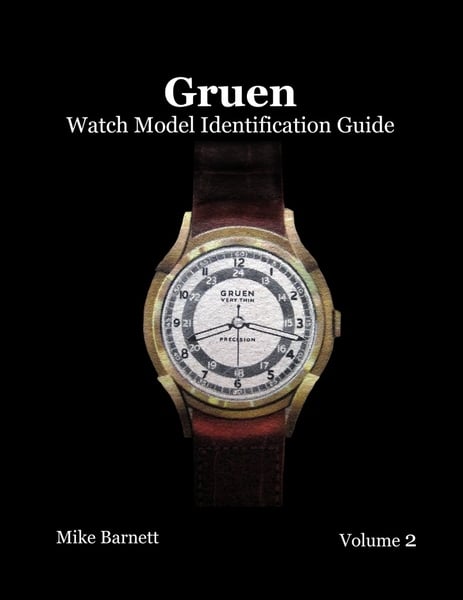
Style Number 752 = 1952..... So, I turned to the section for the year 1951. Typically I search beginning the year PRIOR to the one given by the date table. I do this because the margin of error for Style Numbers is +/- 1 year.
In this situation it's a good thing because I found this watch in the 1951 section of the Gruen Model ID Guide Vol 2 (page 121). I found my DIAL in the model a couple pages further on the All-star 12 model. It wasn't unusual for several dials to be used Gruen watches, so match the watch using the CASE, not the dial. In fact, the data given for the Star Supreme mentions a black dial and a white dial as options.
I can now go on to verify my find, or stop, satisfied that I successfully identified my watch. In this case, I stopped. The match is solid and I'm happy with the results.
Of course, not all identifications are going to be this easy, but a great number are thanks to the publications now available.
Best of luck in your search!
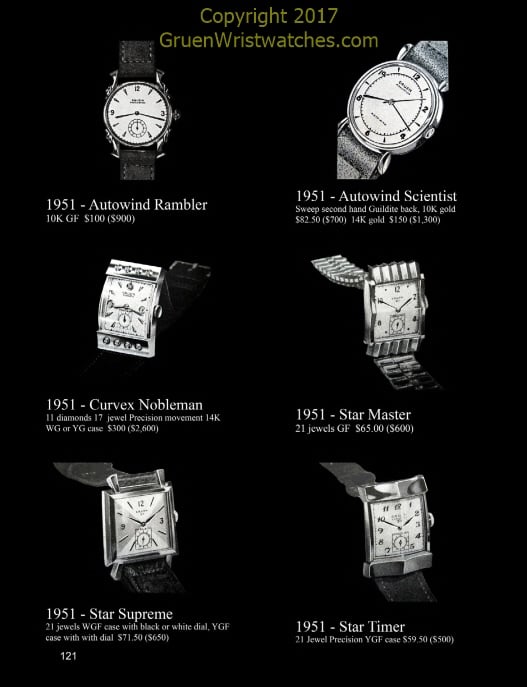
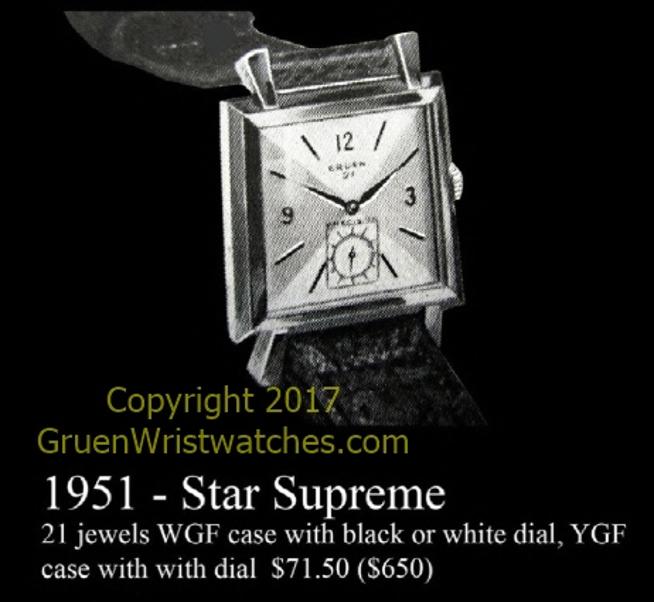
A 1920s Era Strap Watch
You may recall that I said the 1920s era watches are special because of the names found in The Gruen Watch Catalog matching those in the 1927 Stock Record and 1929 Guild books.
In this example, we have the lovely strap watch below. By the way, this particular beautiful Strap watch can be yours. You'll find it for sale in the Gruen Watch Shop. Never miss an opportunity. No shame.
This is our watch that we want to ID. It has a 1920s look about it so step one is to find it in The Gruen Watch Catalog. Even if you didn't know it was from the 1920s, you will learn something by locating it in The Catalog. No harm in adding even the smallest amount of information to your pool of knowledge on the watch.
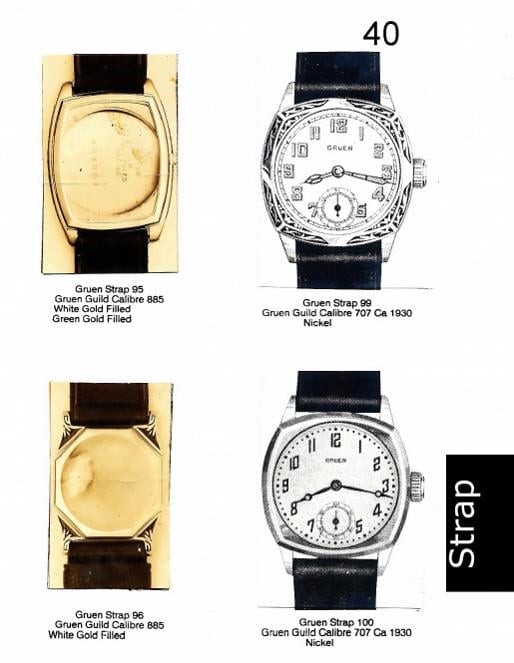
There's our watch! Page 40 of The Catalog.
It says our watch is a "Strap 99". The Catalog goes on to tell us the case is make from Nickel and the movement caliber is a 707.
These are great pieces of verification information. Indeed the watch has a caliber 707 movement.
And our case is a nickel case as can be seen in the back of the case
We're on a roll! We've located a "name" in The Catalog. Now let's go see what else we can learn about it. Because it's a 1920s watch, we can check the two resources dedicated to those years, the 1927 Stock Record Book and the 1929 Guild Book.
Next stop, the Index for those two books.
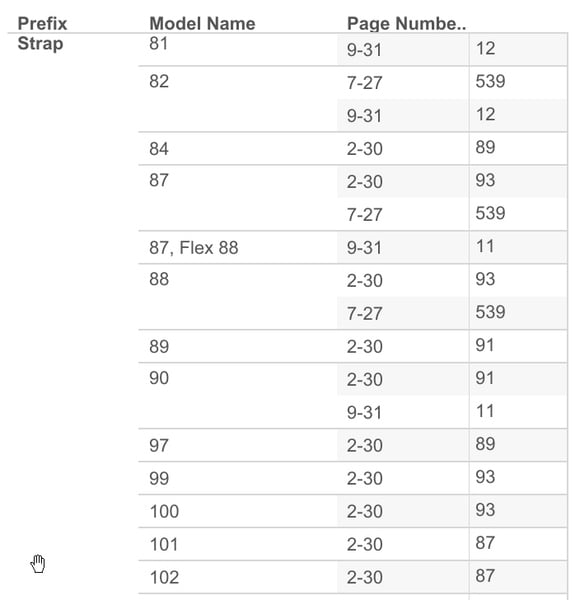
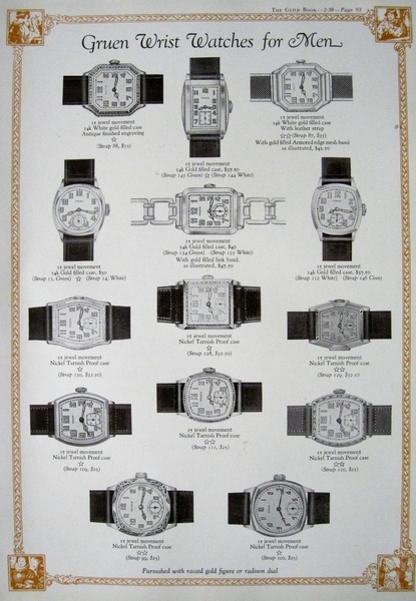
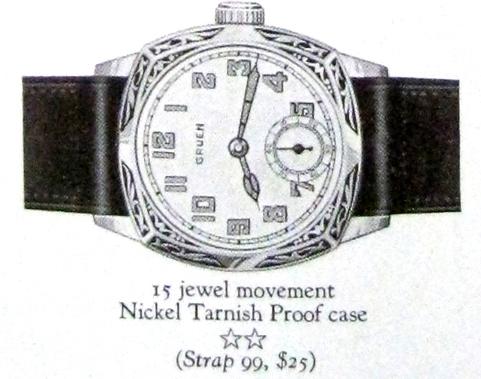
What have we learned by this lookup?
A LOT! One is that the watch is on a page printed in 1930. The page number "2-30 93" tells us that. The prefix 2-30 indicates that the page was from Feb 1930. That is the naming scheme you'll find in both the 1927 and 1929/30/31 books.
That 2-30 date is a key piece of information. That watch was not in the 1927 book, nor was it printed on a 1929 page. So, it was introduced to us first in 1930 in this catalog. The stars that you see with the illustration from the book also have meaning that you will learn when reading more from the Guild Book.
Reading a bit more on that page you'll notice also that a large number of the watches on the page were made from nickel. This is quite unusual for Gruen. When you take one small step back and read the page as a whole like this it adds "color" to the story of the watch. These books bring context to the watches, something you can't get from looking at a typical price guide. It is one of the reasons I believe these 1920s books are special. You get the story, not just the identification.
The result from this research and simple steps using the tools.... I can, with a fair amount of confidence, say that this particular watch is from 1930.
If you wanted to go even further, you could exhaust all of the resources at your disposal. Perhaps look in The 1930s Decade Series book. Go all out! Learn all you can about your watch. Read about Strap watches in general in the 1929 Guild book. There are many opportunities for you to learn while you investigate your specific watch. Take advantage of all of the material you can. Be a Gruen sponge! And then tell us about your watch and what you learned!
© Copyright 2013 & 2015, M. Barnett No re-use implied nor granted. Version 3.0 2016